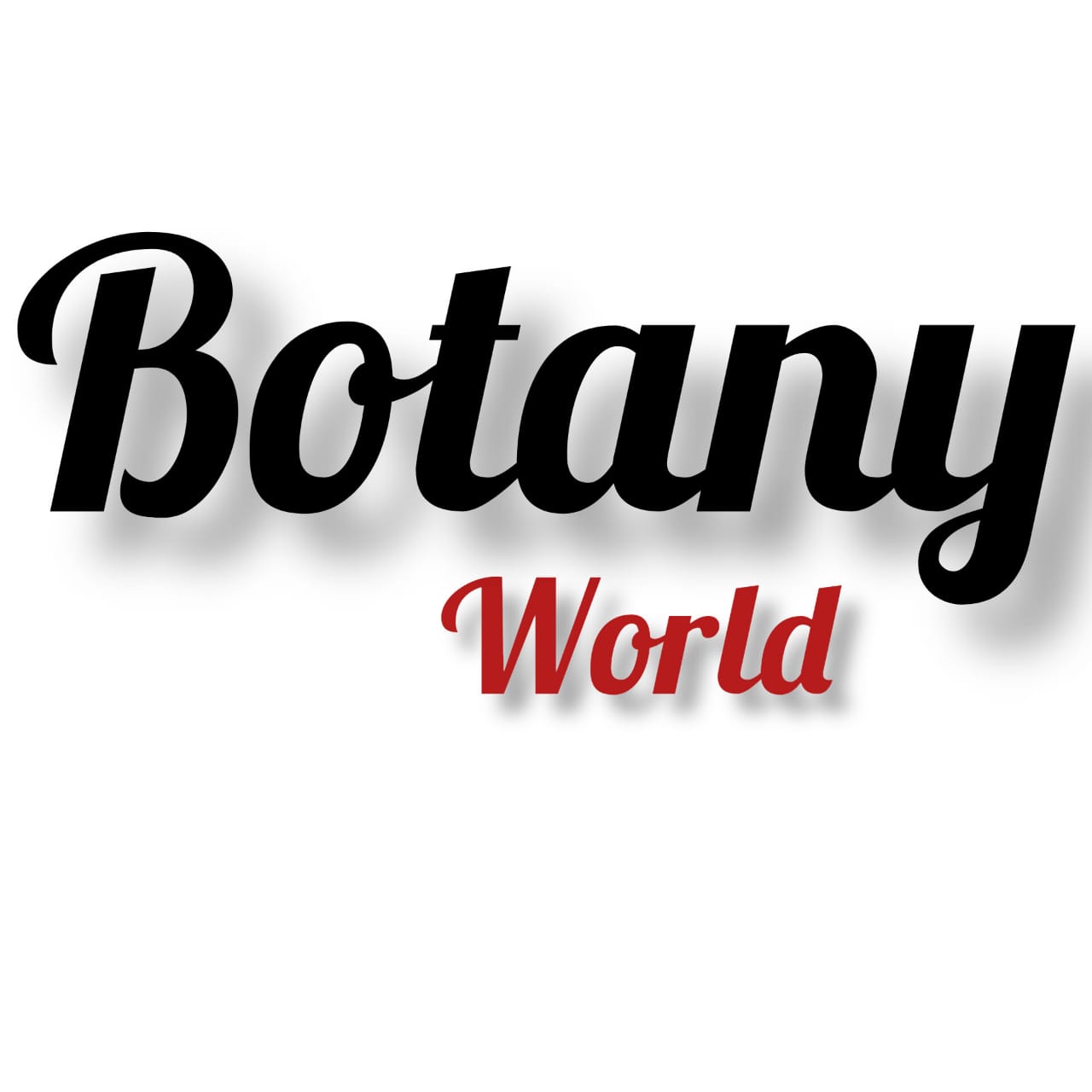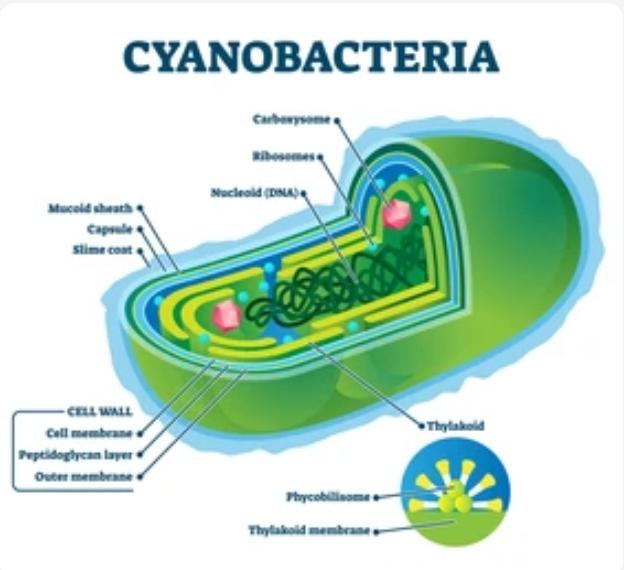Definition of Cyanobacteria
Cyanobacteria, also known as blue-green algae, are a group of photosynthetic bacteria that, like plants, obtain energy through photosynthesis. They are characterized by their ability to produce oxygen and their blue-green color, which is due to the presence of a fluorescent pigment called chlorophyll-a and other pigments such as phycocyanine and phycoerythrin.
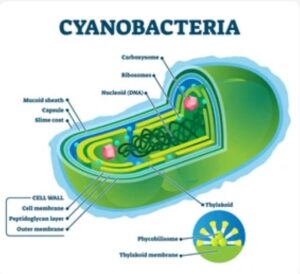
Recently, the name Cyanophyta has been chosen for this region. Previously, this section was called Myxophyta. It belongs to the Cyanophyceae group. Most of the characteristics of the members of this group are similar to bacteria, so the kingdom of bacteria includes the following: Monera.
GENERAL CHARECTERSTICS OF CYANOPHYTA
General characteristics of cyanobacteria are as follow;
Habitat of Cyanobacteria
- The members of this group are called green algae
- Found in fresh water, ponds, canals, drains and wetlands.
- Terrestrial species form layers on moist, compacted soil or bare rock.
- Some species are endophytes, e.g. they live in holes in other trees. Most bryophytes, such as Nostoc, are found in Anthocerọs thallus and
- Anabaena inside some cicadas.
- Lichens are associated with algae. Many grow in the hot spring and turn into hardwood.
- A Very few species of plants are found in the sea.
- They are also found in Warm water in rivers.
Cell structure of Cyanobacteria
- There are very few single-celled organisms, most of which are multicellular and some species are colonial. Cells are embedded in a gelatin membrane
- A row of cells in each group secretes a fiber called trichrome and trichrome.
- Plastids are absent. The chromatoplasm products are found in the cytoplasm.
- Cells have a blue color due to the presence of phycocyanine (the blue color).
- Chlorophyll, carotene and phycoerythrin.
- Cells lack mitochondria, endoplasmic reticulum, and Golgi bodies
- There is no distinct nucleus and the nuclear material is present as a central body without a nucleus.
Reserve food material
- Food storage consists of sugar and glycogen. There are also small oil stains.
- Its cyanophycin protein is also available as a food additive.
- Some members, such as anabaena, can fix nitrogen to form nitrates
Examples /Species of cyanobacteria
Examples of cyanobacteria species are Anabaena, Nostoc, and Oscillatoria etc.
Nostoc
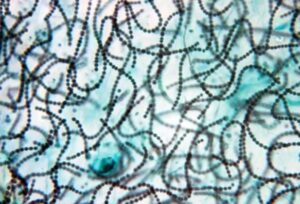
Occurrence
Nostoc is common in freshwater lakes. Large, free-floating colonies are seen as small, round balls. It can be related to aquatic plants. Nostoc can be found in moist soil and rocks, and at the bottom of lakes and streams (both fresh and salt water). And sometimes in marine environments. It can also grow in plant tissues as pods that supply nitrogen to the host in fully differentiated cells called heterocysts. It can be found as part of some lichen mosses.
PLANT BODY
Colony
Numerous folded trichrome are mixed in a gelatinous matrix to form spherical or ellipsoidal green to bluish-green colonies. The colony is externally attached to a tough, hard, granule-like membrane that gives the colony its distinctive shape.
Cell Structure
The cells are of the prokaryotic type. The cells lack mitochondria, endoplasmic reticulum, and Golgi bodies.
It has the following limitations
Cell wall
The protoplast is surrounded by a cell wall made of cellulose
Pigments
There are no plastids, the pigment in the cytoplasm is called chromatoplasm. The cells have a blue color due to the presence of phycocyanine (blue color), chlorophyll, carotene and phycoerythrin.
Nucleoplasm
Without the atoms of the central body, there are no separate atoms and nuclear substances:
Reserve food material
Stored foods contain substances such as sugar, cyanophycin, glycogen and protein.
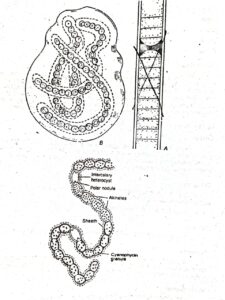
Reproduction
The usual methods of reproduction in Nostoc are vegetative and asexual reproduction. The sexual reproduction by union of gametes is absent.
The reproduction usually takes place by the following methods in the Nostoc.
- Colony Fragmentation
The colony is divided into two or more parts by chance or physiological reason. Each part grows in new groups.
ii.Hormogonia
This is the most common shipping method on Nostoc. The fibers are divided into several pieces in a short length, homogeny is caused by the formation of heterocyst or the death of normal plant cells. This hormone causes the colon pocket to close. They each pick their pockets and then join together to form new groups.
ii.Akinetes
Spores, or resting spores, occur in many nostocs. The plant cell swells, sheds a thick wall around it, and stores a very large amount of food inside to act as an achene. Alkynes usually occur only around homocysts or in chains. It helps the plant to overcome unfavorable conditions. With the onset of favorable conditions, the sperm releases its contents through tubes that end in new filaments.
iv.Arthrospores
The resting spores of akinetes are called arthrospores.
v.Endospores
In some species, for example nostoc microscopium and nostoc commune. The contents of the heterocyst are divided into endospores. These germs emerge and form new fibers.
In some species, e. g., Nostoc Microscopium and N. commune. Heterocyst contents divide to produce endospores. These spores are released and develop into new filaments.
Anabaena
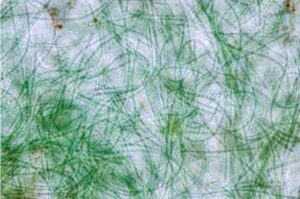
Occurrence
Anabaena is a blue-green filamentous algae. The family includes plankton species, some of which cover other aquatic plants. Some species are indoor plants and grow in the spaces between the leaves of azolla plants and breadfruit trees. Widely distributed in fresh and brackish waters. It usually occurs in aquatic plants. Anabaena species are characterized by the presence of heterocysts and akinetes in their filaments
PLANT BODY
The thallus consists of unbranched filaments in which the cells are joined end to end. Due to the restriction of cell division in only one direction, filaments develop. A single row of cells in the filamentous zone is trichromatic. The filament is very thick and may contain a trichromatic halo that is shaped like achenes and cysts. Fiber movement was reported by the final secondary level vibration.
Cell structure
Plant cells are prokaryotic and characteristically not membrane-bound plastids, with a nucleus, a large central vacuole, mitochondria, Golgi apparatus and endoplasmic reticulum.
Cell wall
Protoplasts are surrounded by cell walls made of amino acid peptides.
Chromoplasm
Chromoplasm contains thin sacs, thylakoids, containing photosynthetic pigments. The thylakoid cannot be distinguished from the cytoplasm. The light substances are related to phycobilins (phycocyanin and phycoerythrin). Chlorophyll and carotenoids. Phycobilins outside the thylakoid. Many small globular grains rich in carbohydrates are distributed throughout the chromosome. It is called starch cyanophyce. Food is stored in protein bodies, cyanophyte granules.
Central body
The central part is the nuclear particle. It is a nucleus that has a definite nucleus and no membrane. Individual resources are often distributed in a networked manner.
Pseudovacuoles
Pseudovacuoles or gas vacuoles are present in Anabaena cells. These are air-filled holes that create buoyancy and help algae rise to the surface.The amount of light in the thylakoid also decreases.
Heterocyst
Heterotrophic cyst is a special type of cell that differs from plant cells in the structure of the wall and the properties of the internal organs. It occurs due to the transformation of plant cells. The proliferating cells assemble a three-layered lateral wall and, in addition to the main wall, the content of granulosa cells decreases and the thylakoid changes to a central or reticular arrangement. These are called polar nodes. Heterocysts make cytoplasmic connections with neighboring cells through these membranes. However, in mature heterologous cells, these holes are filled.
Heterotrophic cysts are among the heterotrophic cysts involved in sites of nitrogen fixation and transport of complex nitrogen to plant cells. There is also evidence that they are involved in the transformation of neighboring plant cells into achenes. In some species, heterocysts act as reproductive structures.
Akinetes
Achenes are non-motile spores that result from the transformation of plant cells. Some plant cells increase and collect cyanophyte granules and strengthen the original cell wall. Thylakoids contain the first skeleton. Akinetes can withstand environmental challenges and grow to produce new fibers when favorable growing conditions are restored. Movements are formed around heterotopic cysts.
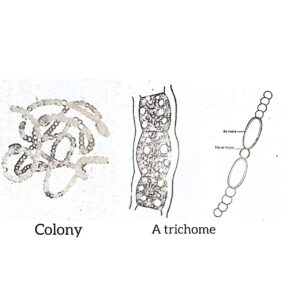
Reproduction
The most common methods of reproduction are vegetative reproduction and reproduction by formation of spores The Sexual reproduction by fusion of gametes is absent
Vegetative Reproduction
Plant reproduction occurs in filaments in a unique pattern known as organogenesis. In this process, the cell chain is divided into multicellular parts. This is because one or more trichome cells have died. In some cases, trichomes are divided into heterotrophs. Hormogonia are often motile and capable of forming new trichomes.
Reproduction by Spore Formation
Asexual reproduction by spore is by akinetes formation and endospores .In some cases heterocysts acts as reproductive structure.
- The akinetes
Achenes develop into new hyphae. The protoplast of the akinetes passes through a transverse fissure and ruptures through the spore wall to form new hyphae.
- Endospores
In some species, for example, Anabaena is divided into Cicada and Heterocysts. After germination, the parts divide into spores, the endosperm, which includes new fibers.
- Heterocyst as Reproductive Structure
Anabaena haleness grows in a heterocyst to form new hyphae, the bottom of the heterocyst divides into two cell fragments which divide into four germ cells. In the equatorial region, the wall of the heterotrophic cyst collapses, a micro-crack appears, and becomes a new thread.
In some cases, the heterotrophic cyst protoplast divides to form numerous small endospores. The spores move through the cracks in the wall and fall to rest in a thick layer. Each endospore grows into a new tube through cell division.
Ocillatoria
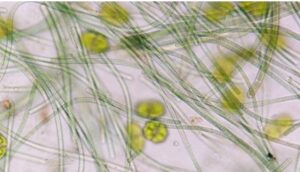
Occurrence
It has a variety of habitats. It is common in fresh water, wet areas, sewers, gutters, and more. They are also observed on the clay surface. It usually occurs in humid climates with an abundance of biodiversity. Tangled lines are seen floating on the surface of freshwater channels.
Thallus
The thallus consists of free trichomes. There are different gaps. Tricolor is a single row of cells. The fibers are nil and the gelatin is very low. The cells are round but wider than long. All designs are above, except for the round top. The septum is slightly enlarged and shows a series of grains.
Cell structure
All trichrome are structurally similar. Cells lack mitochondria, endoplasmic reticulum, and Golgi bodies.
Cell wall
Every cell has a well-developed cell wall. The cell wall is stable and there is almost no membrane behind it.
Pigments
There is no presence of plastids in Oscillatoria. Pigments are found in a thin, cotton-like layer called a layer. There are no flakes in the grain. The cells are blue in color due to the presence of phycocyanine (blue color), chlorophyll, carotene and phycoerythrin.
Nucleoplasm
Every cell has a well-developed cell wall. The cell wall is strong and there are hardly any nuclei.
Reserve food material
Stored food consists of sugars, glycogen, and protein, cyanophycin.
Vacuole
Pseudocysts are also occasionally present in the protoplasts of some species.
Movement
The characteristic of the oscillator is the slow but dynamic movement of the treble. The movement is fast, like a pendulum. This motion is called the swing motion.
Growth
Development of trichrome is intercalary. The crack is rectangular and vertical at the distal end. This increases the length of the trichrome, which does not exceed the width of one cell. Amitotic cell division.
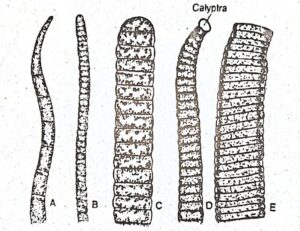
REPRODUCTION
Fragmentation
Fibers are divided into two or more parts. Each part grows into a new plant. Oscillators reproduce in plants. The only way to reproduce is to produce hormones. Degeneration occurs when dead cells are present.
Necridia
During development, triploid cells are destroyed. The protoplast is compressed. Fluid-filled cells are called nuclei. Dead cells lose their boundaries. The pressure on the adjacent cell wall is released. Dead cells become round and look like two cylinders. Cells are separated from dead cells by form or hormones.
Conclusion
In conclusion, cyanobacteria are ancient and fascinating microorganisms that have left a profound impact on the Earth’s history and continue to influence various aspects of our planet’s ecosystems. As one of the earliest life forms on Earth, cyanobacteria played a critical role in shaping the atmosphere by initiating oxygenic photosynthesis, leading to the oxygenation of the planet and enabling the evolution of aerobic organisms.
Their role as primary producers in aquatic ecosystems is vital, as they convert sunlight into organic matter, providing the foundation for food chains and supporting biodiversity. Moreover, cyanobacteria’s ability to fix atmospheric nitrogen is essential for maintaining nutrient levels in the environment and supporting plant growth.
While cyanobacteria contribute positively to the environment, they also pose challenges. Some species can form harmful algal blooms (HABs) under certain conditions, producing toxins that harm aquatic life and pose health risks to humans. Managing and understanding these blooms is crucial for safeguarding water quality and ecological balance.
Cyanobacteria’s diverse habitats, ranging from freshwater to extreme environments, have made them a subject of scientific interest. Their potential applications in biotechnology, such as producing bioactive compounds and biofuels, hold promise for sustainable solutions.
The study of cyanobacteria’s fossil record provides invaluable insights into the Earth’s history, helping us understand the evolution of life and the planet’s early environments.
As we face environmental challenges like climate change and water pollution, a comprehensive understanding of cyanobacteria and their interactions with the environment is essential. Through continued research and responsible management, we can harness the benefits of cyanobacteria while mitigating potential risks, ensuring a balanced and sustainable coexistence with these remarkable microorganisms.
Question/Answers
1. Question: What is the primary role of cyanobacteria in aquatic ecosystems?
Answer: Cyanobacteria serve as primary producers, conducting photosynthesis to convert sunlight into organic matter and providing the foundation of the food chain.
2. Question: How did cyanobacteria significantly impact Earth’s atmosphere?
Answer: Cyanobacteria were among the first organisms to evolve photosynthesis, releasing oxygen as a byproduct. This led to the oxygenation of Earth’s atmosphere, enabling the development of aerobic life forms.
3. Question: What is the process of nitrogen fixation, and why is it important in relation to cyanobacteria?
Answer: Nitrogen fixation is the conversion of atmospheric nitrogen into a usable form by certain bacteria, including cyanobacteria. This process is vital for maintaining nitrogen levels in the environment and supporting plant growth.
4. Question: What are harmful algal blooms (HABs), and how are they related to cyanobacteria?
Answer: Harmful algal blooms (HABs) are rapid and excessive growths of algae, including cyanobacteria, that produce toxins harmful to humans and aquatic life. Cyanobacteria are sometimes responsible for causing these harmful blooms.
5. Question: What is the significance of cyanobacteria in the global carbon cycle?
Answer: Cyanobacteria play a role in the global carbon cycle by sequestering carbon dioxide during photosynthesis, contributing to carbon storage in aquatic ecosystems.
6. Question: Where can cyanobacteria be found in nature?
Answer: Cyanobacteria can be found in various environments, such as freshwater lakes, ponds, oceans, soil, hot springs, deserts, and even in polar regions.
7. Question: How have cyanobacteria contributed to the field of biotechnology?
Answer: Cyanobacteria have attracted attention in biotechnology and bioengineering due to their ability to produce various bioactive compounds, biofuels, and potentially serve as a sustainable source of food.
8. Question: What information does the fossil record of cyanobacteria provide about the history of life on Earth?
Answer: The fossil record of cyanobacteria dates back billions of years, making them one of the oldest known life forms on Earth. Their presence in ancient rocks provides insights into the history of life and the planet’s early environment.
9. Question: How can the growth of cyanobacteria be controlled in aquatic ecosystems?
Answer: The growth of cyanobacteria can be controlled through various methods, such as reducing nutrient inputs (e.g., phosphorus and nitrogen), improving water circulation, and implementing proper wastewater treatment.
10. Question: How do scientists utilize cyanobacteria to study the origins of life on Earth and potential extraterrestrial life?
Answer: Cyanobacteria are used as model organisms to study early life and the evolution of photosynthesis. Additionally, their ability to survive in extreme environments has implications for the search for life on other planets.
